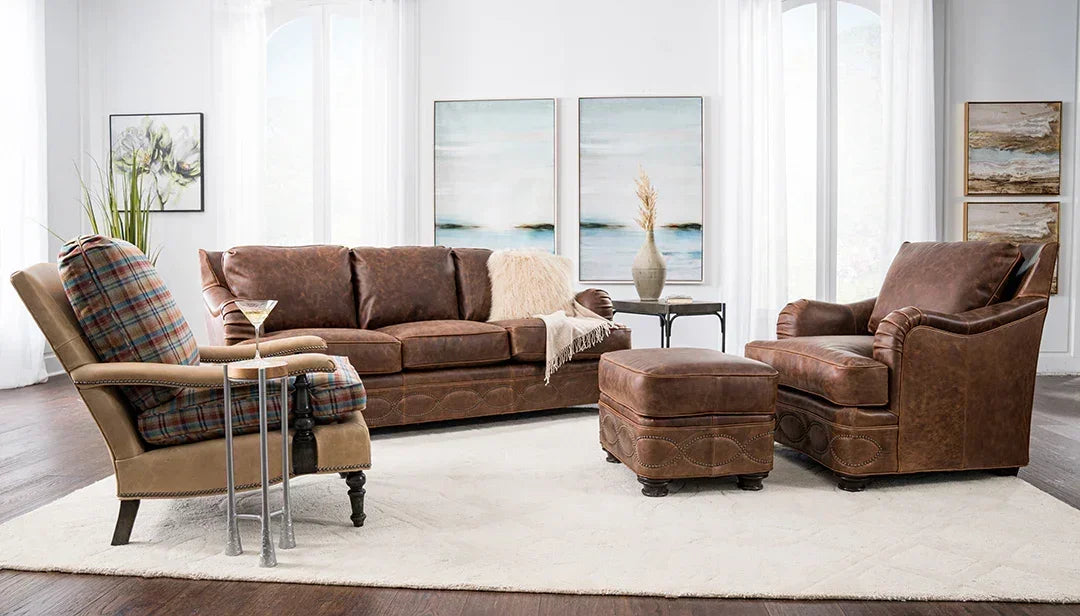Layering rugs is one of the easiest ways to give your space texture, dimension, and warmth—especially when you're aiming for that collected, Western-inspired aesthetic. Whether you're using flat woven kilims, rustic cowhides, or classic American rugs as your base, rug layering helps anchor your furniture, highlight special areas, and make a room feel intentional and lived-in.
Here's how to layer your rugs like a pro.
Start with a Solid Base
The foundation of any layered rug look is a larger base rug that defines your space. American-made rugs are a perfect starting point. Durable, beautifully patterned, and rooted in tradition, they create a canvas that lets your top-layer rug shine.
We recommend starting with something neutral or textured like jute or burlap rugs if your top rug has color and pattern. If you're using a cowhide or flat kilim as your base, choose from our American rugs collection for a bold Southwestern or geometric touch.
Pro tip: The ideal rug size for most living areas is 8' x 10' or larger. Use painter's tape to map the dimensions on your floor before purchasing to ensure your furniture fits well. Ideally, all the legs of your furniture should sit on the rug or at least halfway.
Add Texture with Cowhide or Kilim
Once you've got your base, it's time to layer. This is where things get fun.
Consider a striking cowhide rug layered on top of your American-made base. The natural shape and rich texture of cowhide instantly add a sense of authenticity and movement to the space. Plus, cowhide pairs beautifully with hardwood floors and leather furniture.
For a more global flair, layer a smaller kilim or tribal-style accent rug. Kilims are thinner, tightly woven rugs often rich in color and pattern. They look incredible centered under a coffee table or the foot of a bed.
Choose the Right Size Combinations
Size matters when layering rugs. Here's a quick guide to get the proportions right:
-
Start with an 8' x 10' base rug.
-
Layer it with a 5' x 8', 6' x 9', or 4' x 7' rug, depending on your space and furniture.
If you have a lightweight, open-legged coffee table, a smaller accent rug will still stand out underneath. But if your furniture is chunkier or darker in color, go for a slightly larger top rug so it doesn't get lost visually.
Use Rug Layering to Highlight a Zone
One of the best uses for rug layering is to highlight a specific area. Whether you want to draw attention to a coffee table, bench, or reading nook, placing a contrasting rug underneath helps define that space and anchor the elements.
Try layering a kilim or cowhide rug in your entryway or under a decorative bench. It's also a beautiful way to frame a vintage trunk, chest, or other heirloom piece.
Try Rug Layering in Unexpected Spots
Layered rugs aren't just for living rooms. Bring this styling trick into:
-
Bedrooms: Use a jute base and a striped or patterned kilim at the foot of the bed.
-
Entryways: Stack a small, shaped cowhide over a durable American rug to wow guests the moment they walk in.
-
Stairways: Don't forget to check out our rug stair treads if you love the layered look across vertical spaces.
Product Pairing Ideas from Our Collection
Here are a few rug combos we love:
-
Base: American Made Aztec-Inspired Rug
Top: Kilim-style runner -
Base: Rustic Burlap Rug
Top: Triangular cowhide for an angled entryway pop
These combinations create layered looks full of personality and charm. By mixing textures and thoughtfully choosing rug sizes, you can achieve a cozy, high-end style that feels both Western and worldly.
Ready to Start Layering?
Browse our full collection of American rugs, cowhides, and jute rugs to build your perfect layered look. Whether you're decorating a mountain cabin or bringing rustic warmth into your home, rug layering is one of the most accessible ways to elevate your space with texture and intention.



